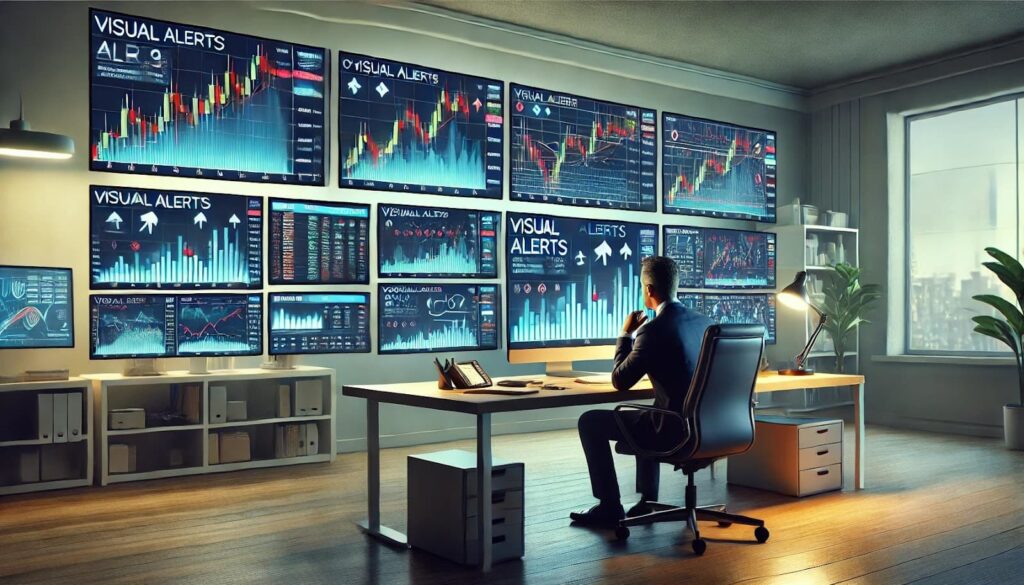When trading, minimizing distractions is crucial for staying focused on the markets. For many traders, sound notifications can be disruptive, especially when multitasking or working in a quiet environment. Using visual alerts instead of sound notifications allows traders to stay informed while maintaining concentration. Visual alerts, such as pop-up windows, color changes on charts, or highlighted price levels, are effective ways to monitor price movements or technical indicator signals without the need for audio cues. These alerts can be customized based on specific market conditions, offering a non-intrusive method to track trades and set entry or exit points.
Platforms like the Exness web terminal provide a robust set of visual alert options that traders can easily set up. With features such as chart-based color changes or pop-up notifications, traders can receive timely updates on their trades without disrupting their workflow. Customizing visual alerts allows traders to tailor their notifications to highlight crucial market events, helping them make informed decisions while maintaining a distraction-free environment. Whether using simple visual signals or more complex chart overlays, leveraging visual alerts can improve overall trading efficiency by reducing unnecessary distractions.
Understanding Visual Alerts in Trading
Visual alerts in trading refer to notifications displayed on a trader’s platform to signal specific market events, such as price changes, technical indicator crossovers, or trend reversals. These alerts are a non-intrusive way to keep traders informed without relying on sound notifications. They can appear in various forms, such as pop-up windows, color changes in charts, or the appearance of arrows and indicators directly on the price charts. Visual alerts allow traders to monitor market conditions in real-time while staying focused on their analysis without the distractions of auditory cues.
Unlike sound notifications, which can disrupt a trader’s workflow and potentially lead to distractions, visual alerts offer a more subtle approach. By setting up custom alerts based on their specific criteria, traders can focus on the most relevant signals and avoid being overwhelmed by unnecessary notifications. Visual alerts are particularly beneficial in environments where noise is a concern, such as quiet offices or when multitasking. They also allow traders to integrate alerts directly with their charting and analysis, enhancing their ability to respond to changes in the market more effectively.
The key advantage of visual alerts is their adaptability and customization. Traders can define specific conditions under which these alerts trigger, such as when a price crosses a particular threshold or when a moving average crossover occurs. This level of customization helps ensure that traders are notified only of the most pertinent events, reducing the noise and improving the decision-making process. By leveraging visual alerts, traders can receive real-time updates on their strategies while maintaining focus and avoiding interruptions from sound notifications.
Types of Visual Alerts
There are several types of visual alerts used in trading, each offering a different way to monitor market conditions and notify traders of key events. The most common types include:
Chart-Based Alerts:
These alerts appear directly on the price charts and can take various forms, such as color changes in candlesticks, arrows, or shaded areas. For example, a trader might set up an alert that highlights a candlestick in a different color when the price crosses a specific moving average, signaling a potential buy or sell opportunity. Chart-based alerts are helpful because they integrate seamlessly with the trader’s analysis, making it easy to spot significant price movements at a glance.
Pop-Up Alerts:
These are small, on-screen notifications that appear in a corner of the trading platform or as a separate window. Pop-up alerts are triggered when certain conditions are met, such as when a price reaches a predefined level or a technical indicator signals a change. Traders can set these alerts to display relevant information, such as the current price or a reminder of specific market conditions, allowing them to quickly assess whether action is required.
Overlay Alerts:
These alerts involve placing indicators or text directly on the chart. For example, traders might set an overlay alert that displays a message on the chart when a specific condition is met, such as “Buy Signal” or “Bearish Divergence.” Overlay alerts provide a constant reminder of the trading strategy and ensure that key signals are always visible during market analysis.

Benefits of Using Visual Alerts Without Sound Notifications
Using visual alerts instead of sound notifications helps traders maintain focus, reduce distractions, and customize their market monitoring experience. This approach ensures a quieter, more efficient trading environment while enhancing decision-making.
| Benefit | Description |
| Reduced Distractions | Visual alerts prevent interruptions from loud notifications, allowing traders to stay focused on analysis and execution. |
| Enhanced Productivity | Eliminating sound alerts helps maintain concentration, leading to better decision-making and improved trading efficiency. |
| Customizable Alerts | Traders can set specific visual triggers for price changes, trend reversals, and indicator signals to receive only relevant updates. |
| Ideal for Quiet Environments | Useful for traders working in noise-sensitive areas or managing multiple screens without disruptive audio. |
| Prevention of Information Overload | Visual cues provide clear, selective updates, avoiding the constant interruptions caused by frequent sound alerts. |
Best Practices for Using Visual Alerts for Trading
To maximize the effectiveness of visual alerts in trading, it’s essential to follow best practices that ensure they provide the right information without becoming overwhelming. Here are some key best practices for using visual alerts:
- Set Appropriate Thresholds: One of the most important aspects of visual alerts is ensuring they trigger at the right moments. Set alerts for specific price levels, technical indicators, or chart patterns that are critical to your trading strategy. Avoid setting too many alerts for minor price fluctuations, as this could lead to information overload and distract you from the most important signals.
- Use Clear and Distinct Visual Signals: Choose alert styles that are easy to identify at a glance, such as color-coded candlesticks, bold arrows, or well-placed pop-ups. The visual cues should be distinguishable from the rest of the chart or platform, making it simple to spot an alert when it appears. Additionally, using contrasting colors or shapes can help make the alerts more noticeable without being distracting.
- Limit the Number of Alerts: While visual alerts are beneficial, too many of them can lead to confusion and reduced effectiveness. Prioritize alerts that are most relevant to your trading strategy and remove any unnecessary alerts. By focusing on the most important conditions, you can keep your chart clean and free from excessive notifications.
- Customize Alerts for Different Market Conditions: Tailor visual alerts to match the different stages of your trading plan. For example, set specific alerts for key support and resistance levels, trend reversals, or indicator crossovers. By customizing alerts to your strategy, you can ensure that you’re alerted only when the conditions align with your trading approach, leading to more efficient decision-making.
- Test and Adjust Alert Settings: It’s crucial to regularly review and adjust your alert settings based on your trading experience. Test your alerts in a demo environment to ensure they trigger as expected and that they provide useful information. Adjust the parameters if necessary to improve their accuracy or relevance. Over time, fine-tuning your alerts can help optimize your workflow and improve your trading performance.
Conclusion
Visual alerts offer traders a focused, distraction-free way to stay informed about key market events without relying on sound notifications. By using customizable alerts, such as color changes on charts, pop-up windows, or indicator overlays, traders can monitor important price movements, trend reversals, or technical signals in real time. These visual cues allow traders to remain immersed in their analysis without being interrupted by the constant sound of notifications, which can be especially helpful in quiet environments or when multitasking. With visual alerts, traders can customize the types and frequency of alerts to suit their specific strategies, ensuring they receive only the most relevant information.
By adopting visual alerts, traders can improve their decision-making process while maintaining a clear and organized trading workspace. Visual signals are easy to spot and can be tailored to match individual trading preferences, helping to highlight critical events or levels on charts. This approach reduces the risk of information overload, as traders can filter out unnecessary alerts and focus on the most important market conditions. Ultimately, using visual alerts in place of sound notifications enhances the efficiency and effectiveness of a trader’s workflow, leading to a more streamlined and productive trading experience.
